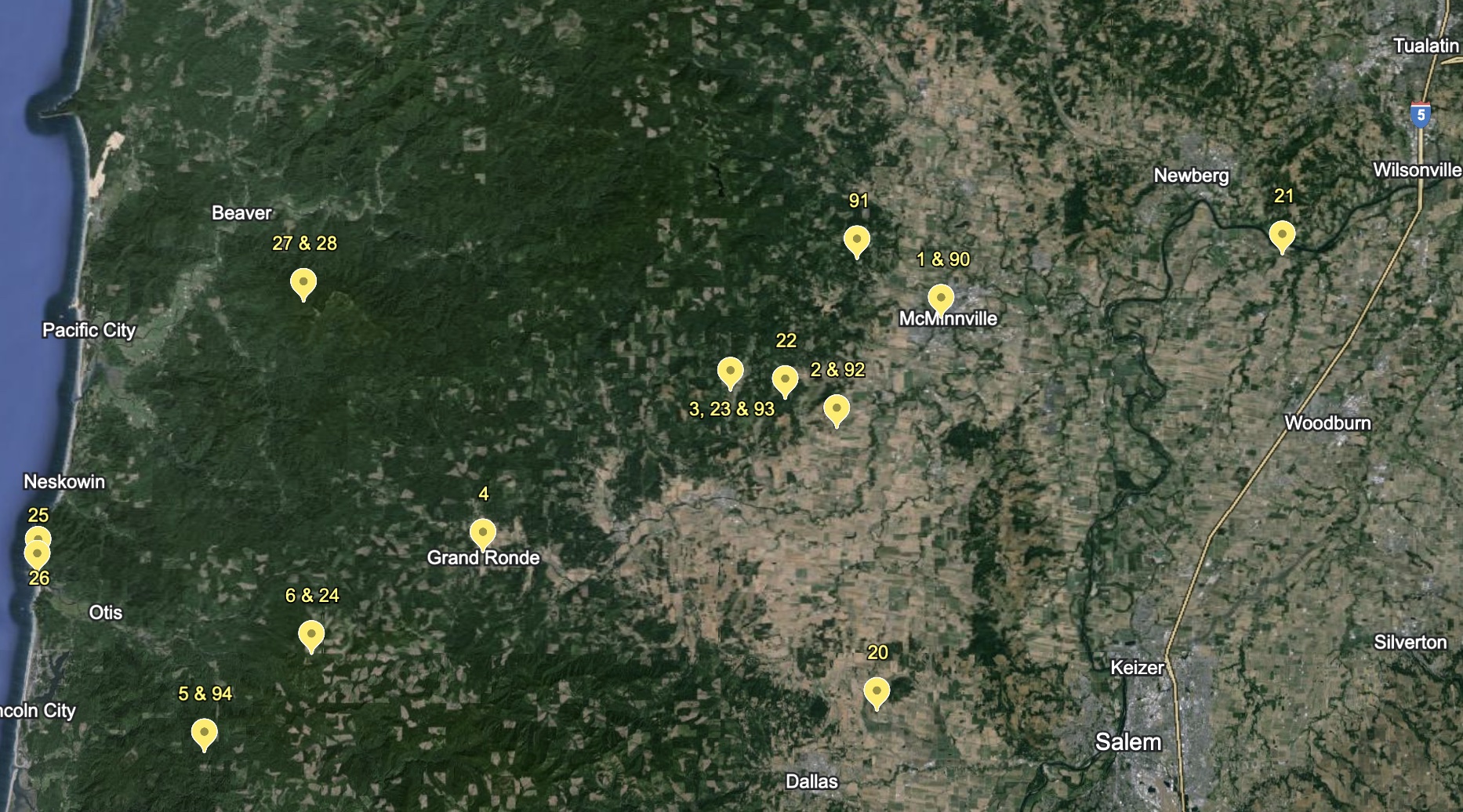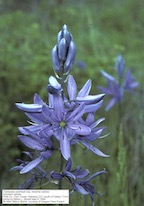NPSO 2024 Annual Meeting
May 17 - 19 Spirit Mountain Hotel, Grand Ronde, Oregon
Field Trips
This section gives an overview of the field trips for each day. Click on the field trip name to see detailed information about each hike, including descriptions, photographs, meeting location, driving directions and plant lists. Please bring water to drink on your field trip.
All driving is on paved roads unless otherwise noted.
Checking for ticks is always wise after venturing into natural areas.
Please refer to the map at the bottom of this page to see the general location of fieldtrips.
Friday May 17, 2024 ------------------ Field Trips
1
Native Plant Garden at McMinnville Library Leader: Rob Tracey
1 - 4 p.m. Easy
Stroll through the garden to enjoy 95 labeled species of plants indigenous to the Willamette Valley and surrounding low elevation Cascade and Coast Ranges. Many will come into bloom during the Annual Meeting. Established in 1999, the garden is maintained by volunteers from the Cheahmill Chapter. Questions about propagation and ethnobotany are welcome.
2
Erratic Rock and Yamhill Valley Vineyards Leader: Lisa Blackburn
1 - 4 p.m. Easy to moderate (0.5 miles)
Walk on a paved trail to see an erratic rock that floated into the Willamette Valley in an iceberg and was deposited on a hillside 250 feet above the valley floor. Learn about Ice Age floods that brought such rocks to the valley from Canada. Thereafter, we will travel a short distance to Yamhill Valley Vineyards. Established in 1983, Yamhill Valley Vineyards is the oldest winery in the McMinnville AVA. We will tour the vineyards and learn about their sustainable farming practices.
3
Deer Creek Prairie Park Leader: Dave Hanson
1 - 4 p.m. Easy (0.5 mile)
This is Yamhill County's most biologically diverse park, with upland and wet prairies, beaver ponds, and riparian habitats. After many attempts to farm the site, it was abandoned and acquired by Yamhill County. It is now a designated mitigation site for enhancement of threatened Fender's blue butterfly populations and its host species, threatened Kincaid's lupine.
4
Chachalu Tribal Museum and Cultural Center Leaders: Chachalu Tribal Museum & Cultural Center staff
1 - 4 p.m. Easy
Chachalu tells the story of the Tribes and Bands of the Confederated Tribes of the Grand Ronde Community of Oregon and honors Elders who kept Tribal traditions and dreams alive during the years of Termination.
5
Drift Creek Falls Leader: Bruce Waugh
1 - 4 p.m. Easy (3-miles round-trip, plus optional 1-mile North Loop to view old growth)
Hike through a beautiful forest of Douglas fir, western hemlock, western red cedar, and other coastal woodland species to cross a 100 foot high suspension bridge overlooking a spectacular 75 foot waterfall as it cascades over columnar basalt. Crossing the bridge is not mandatory.
6
Lost Prairie and Saddle Bag Mountain Leader: Heidi Christensen
1 - 4 p.m. Easy to moderate (1 or more miles)
Lost Prairie was designated as an Area of Critical Environmental Concern to protect 60 acres of mid- to high-elevation sedge fen,
Sphagnum bog, and beaver marshes in the Oregon Coast Range. The fen supports a diverse array of vascular plants and bryophytes that are uncommon in coastal coniferous forests of northwestern Oregon. Saddle Bag Mountain Research Natural Area occupies 300 acres on the 3,290-foot summit and western slopes of the mountain and was established to protect one of the last remaining stands of Pacific silver fir in the Oregon Coast Range. Many of the trees at the site are between 250 and 400 years old. This site is normally inaccessible to the public.
Saturday May 18, 2024 ------------------ Field Trips
20
Baskett Slough National Wildlife Refuge and Delbert Hunter Arboretum and Botanical Garden Leaders: Tom Kaye, Esther McEvoy
9 a.m. - 4 p.m. Fairly easy (4 miles at refuge)
The view from this National Wildlife Refuge (NWR) stretches from the Willamette Valley to the foothills of the Cascade Range. Varied habitats include wetland, wet and dry prairie, oak woodland, and mixed forest. The refuge is home to the largest known population of Fender's blue butterfly and its host plant, Kincaid's lupine, as well as golden paintbrush and Willamette daisy. Leaders will discuss efforts to improve habitat, reintroduce native plant species, and restore plant communities. After Baskett Slough, we will head to Dallas for the Delbert Hunter Arboretum and Botanical Garden where we can admire native northwest plants and trees.
21
Champoeg State Heritage Area Leaders: Sara Alaica, Lisa Blackburn
9 a.m. - 4 p.m. Easy to moderate
We will visit Champoeg State Heritage Area where the Institute for Applied Ecology is helping to restore a 45-acre prairie that eventually will be a traditional tribal harvest area. Beyond the restoration area, Champoeg State Heritage Area features a rare combination of history, nature, and recreation. Situated south of Newberg along the scenic Willamette River, Champoeg's forests, fields, and wetlands recreate the landscape of a bygone era.
22
Masonville and Muddy Valley Habitat Reserves Leaders: Josh Togstad, Chris Seal
9 a.m. - 4 p.m. Easy to moderate (2- to 3-mile hikes at each site)
These adjacent sites are managed by the Yamhill Soil & Water Conservation District. At Masonville, major habitat types in the Willamette Valley (wet and upland prairie, marsh, riparian, white oak savanna, and coniferous forest) are being restored. Douglas fir was removed to restore oak habitat, followed by seeding with native grasses and forbs. Muddy Valley includes 540 acres of wet prairie, oak savanna, mixed forest, and ponds with western pond turtles. Both offer excellent examples of how partnerships have enabled a transition to high quality habitats. These sites are normally inaccessible to the public.
23
Deer Creek Prairie Park and Yamhill Oaks Preserve Leaders: Dave Hanson, Amie Loop-Frison, Paul Hammond, Lynda Boyer, James McAuliffe
9 a.m. - 4 p.m. Easy to moderate (1 mile at Deer Creek Park; 1.5 miles at Yamhill Oaks Preserve)
Deer Creek is Yamhill County’s most biologically diverse park, with upland and wet prairies, beaver ponds, and riparian habitats. It is a designated mitigation site for enhancement of threatened Fender’s blue butterfly populations and its host species, threatened Kincaid’s lupine. Yamhill Oaks is a 313-acre remnant upland prairie and oak woodland with over 27 at-risk species and is home to one of the largest populations of threatened Fender’s blue butterfly. A special feature will be a butterfly tour and walk with lepidopterist Paul Hammond. Yamhill Oaks is normally inaccessible to the public.
24
Lost Prairie and Saddle Bag Mountain Leader: Dan Luoma
9 a.m. - 4 p.m. Easy to moderate with a strenuous option (about 1 mile total)
Lost Prairie was designated as an Area of Critical Environmental Concern to protect 60 acres of mid- to high-elevation sedge fen,
Sphagnum bog, and beaver marshes in the Oregon Coast Range. The fen supports a diverse array of vascular plants and bryophytes that are uncommon in coastal coniferous forests of northwestern Oregon. Saddle Bag Mountain Research Natural Area occupies 300 acres on the 3,290-foot summit and western slopes of the mountain and was established to protect one of the last remaining stands of Pacific silver fir in the Oregon Coast Range. Many of the trees at the site are between 250 and 400 years old. This site is normally inaccessible to the public.
25
Salmon River Estuary Leader: Kami Ellingson
9 a.m. - 4 p.m. Easy
The Estuary forms a bay between two basalt headlands. In 1960, salt marshes were diked to exclude saltwater to provide areas for pasture. Restoration efforts focus on restoring native plant communities and controlling erosion and noxious weeds. The trip will visit two restoration projects and discuss what was learned about the recovery of native vegetation and the return of juvenile salmon to the estuary.
26
Cascade Head Nature Conservancy Preserve Leaders: Sophie Linden, Dave Pickering, Aislinn Adams
9 a.m. - 4 p.m. Moderate to strenuous (4.2 miles)
Cascade Head is a basalt headland offering a spectacular view of the Oregon coast and the Salmon River Estuary. The trail begins with a steep climb through a coastal rainforest of Sitka spruce and western hemlock and emerges onto a coastal prairie, home to numerous native wildflowers.
27
Mt. Hebo - Driving Leaders: Hope Stanton and Bruce Waugh
9 a.m. - 4 p.m. Easy (1 mile round trip)
This peak in the Coast Range is a 2.5-mile-long ridge at over 3100 feet elevation, offering panoramic views of the ocean and eight Cascade peaks. Soils on the hard, basaltic rocks are shallow, covered with mosses, boggy areas with
Sphagnum, and numerous wildflowers, such as dwarf camas and Cardwell’s penstemon. A short walk through the forest reveals fawn lilies, orchids, and more.
28
Mt. Hebo - Hiking Leaders: OSU Botany Club, Botany and Plant Pathology Graduate Students Association
9 a.m. - 4 p.m. Moderate to strenuous (4 miles)
This peak in the Coast Range is a 2.5-mile-long ridge at over 3100 feet elevation, offering panoramic views of the ocean and eight Cascade peaks. Participants will hike through a beautiful coastal forest, visit sites with shallow soils on basaltic rocks covered with mosses, boggy areas with
Sphagnum, and wildflowers, such as dwarf camas and Cardwell’s penstemon and may have the opportunity to visit meadows where two culturally significant species of
Vaccinium are managed by Forest Service and tribal members.
Sunday May 19, 2024 ------------------ Field Trips
90
Native Plant Garden at McMinnville Library Leader: Rob Tracey
9 a.m. - Noon Easy
Stroll through the garden to enjoy 95 labeled species of plants indigenous to the Willamette Valley and surrounding low elevation Cascade and Coast Ranges. Many will come into bloom during the Annual Meeting. Established in 1999, the garden is maintained by volunteers from the Cheahmill Chapter. Questions about propagation and ethnobotany are welcome.
91
Miller Woods Conservation Area Leaders: Rachel Kato, Jim Kreutzbender
9 a.m. - Noon Easy or moderate (0.3 mile interpretive walk and optional 4.5 miles)
Located west of McMinnville in the foothills of the Coast Range, Miller Woods includes 130 acres with an extensive trail system highlighting a wide array of ecosystems, from oak savanna to conifers of varying ages, ponds, and streams that are home to a diverse group of native plants, birds, and other wildlife. An on-site native plant nursery provides plants for restoration projects.
92
Erratic Rock and Yamhill Valley Vineyards Leader: Lisa Blackburn
9 a.m. - Noon Easy to moderate (0.5 mile)
Walk on a paved trail to see an erratic rock that floated into the Willamette Valley in an iceberg and was deposited on a hillside 250 feet above the valley floor. Learn about Ice Age floods that brought such rocks to the valley from Canada. Thereafter, we will travel a short distance to Yamhill Valley Vineyards. Established in 1983, Yamhill Valley Vineyards is the oldest winery in the McMinnville AVA. We will tour the vineyards and learn about their sustainable farming practices.
93
Deer Creek Prairie Park Leader: Dave Hanson
9 a.m. - Noon Easy (0.5 mile)
This is Yamhill County's most biologically diverse park, with upland and wet prairies, beaver ponds, and riparian habitats. After many attempts to farm the site, it was abandoned and acquired by Yamhill County. It is now a designated mitigation site for enhancement of threatened Fender's blue butterfly populations and its host species, threatened Kincaid's lupine.
94
Drift Creek Falls Leader: Self-guided tour
Easy (3-miles round-trip, plus optional 1-mile North Loop to view old growth)
Hike through a beautiful forest of Douglas fir, western hemlock, western red cedar, and other coastal woodland species to cross a 100-foot high suspension bridge overlooking a spectacular 75-foot waterfall as it cascades over columnar basalt.

Approximate locations of field trips by trip number.



